Evaluating Renewable Energy's Viability at a National Level
VerifiedAdded on 2021/06/17
|18
|2717
|60
Report
AI Summary
This report assesses the feasibility of pursuing renewable energy on a national level, specifically focusing on Australia. It analyzes economic factors, such as the higher costs of generating renewable energy compared to non-renewable sources, and the need for government policies to control costs and incentivize investment. Technological factors are examined, highlighting the importance of reducing carbon dioxide emissions and the current limitations of renewable energy technologies in terms of cost-effectiveness. Political factors, including government policies and support, are discussed, along with social factors, such as public acceptance and trust in renewable energy technologies. The report concludes that while renewable energy technologies have developed, cost efficiency remains a challenge, and strategies to improve this are needed. The report also suggests that the government should invest in campaigns to educate the public about the long-term benefits of renewable energy to overcome social constraints.
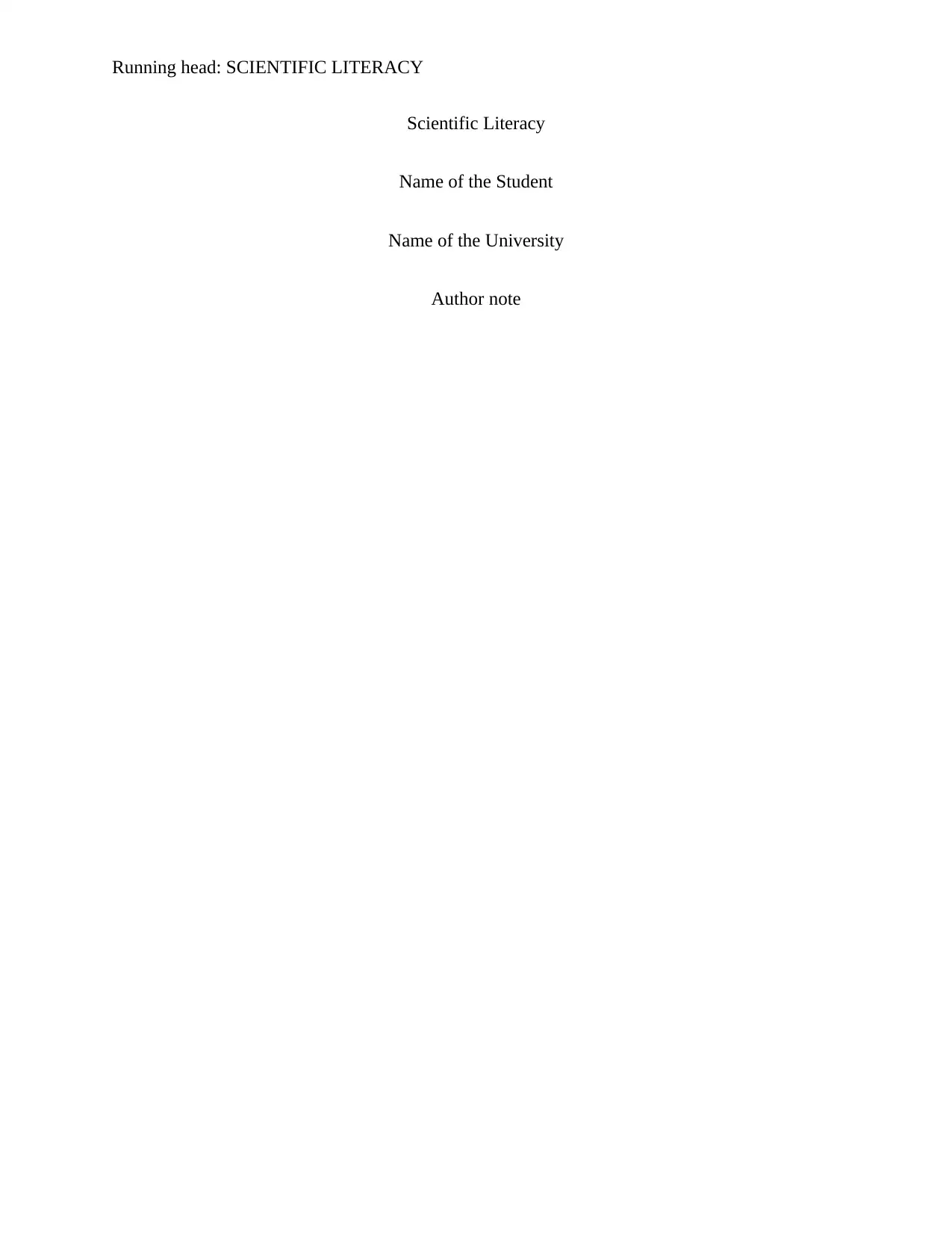
Running head: SCIENTIFIC LITERACY
Scientific Literacy
Name of the Student
Name of the University
Author note
Scientific Literacy
Name of the Student
Name of the University
Author note
Paraphrase This Document
Need a fresh take? Get an instant paraphrase of this document with our AI Paraphraser
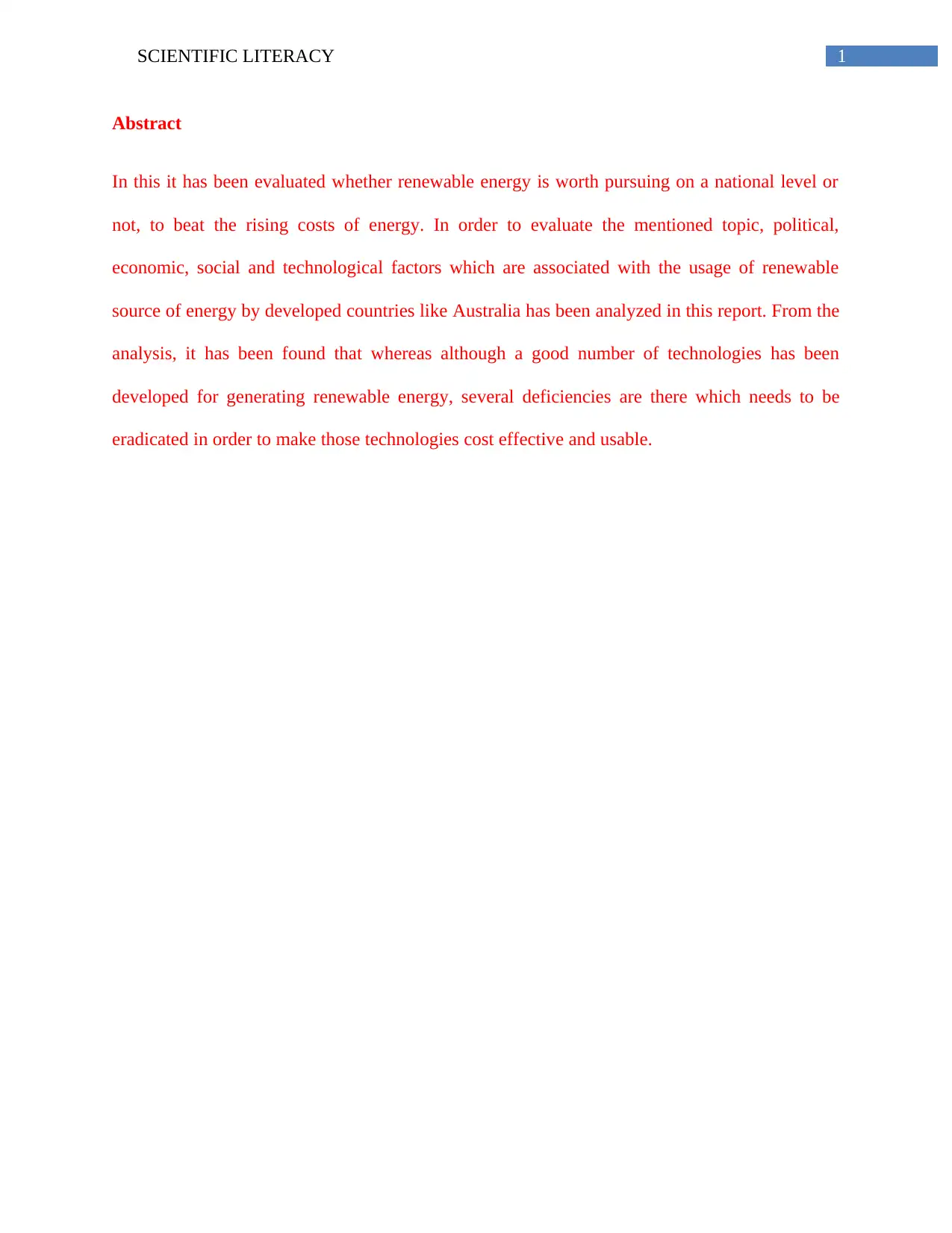
1SCIENTIFIC LITERACY
Abstract
In this it has been evaluated whether renewable energy is worth pursuing on a national level or
not, to beat the rising costs of energy. In order to evaluate the mentioned topic, political,
economic, social and technological factors which are associated with the usage of renewable
source of energy by developed countries like Australia has been analyzed in this report. From the
analysis, it has been found that whereas although a good number of technologies has been
developed for generating renewable energy, several deficiencies are there which needs to be
eradicated in order to make those technologies cost effective and usable.
Abstract
In this it has been evaluated whether renewable energy is worth pursuing on a national level or
not, to beat the rising costs of energy. In order to evaluate the mentioned topic, political,
economic, social and technological factors which are associated with the usage of renewable
source of energy by developed countries like Australia has been analyzed in this report. From the
analysis, it has been found that whereas although a good number of technologies has been
developed for generating renewable energy, several deficiencies are there which needs to be
eradicated in order to make those technologies cost effective and usable.
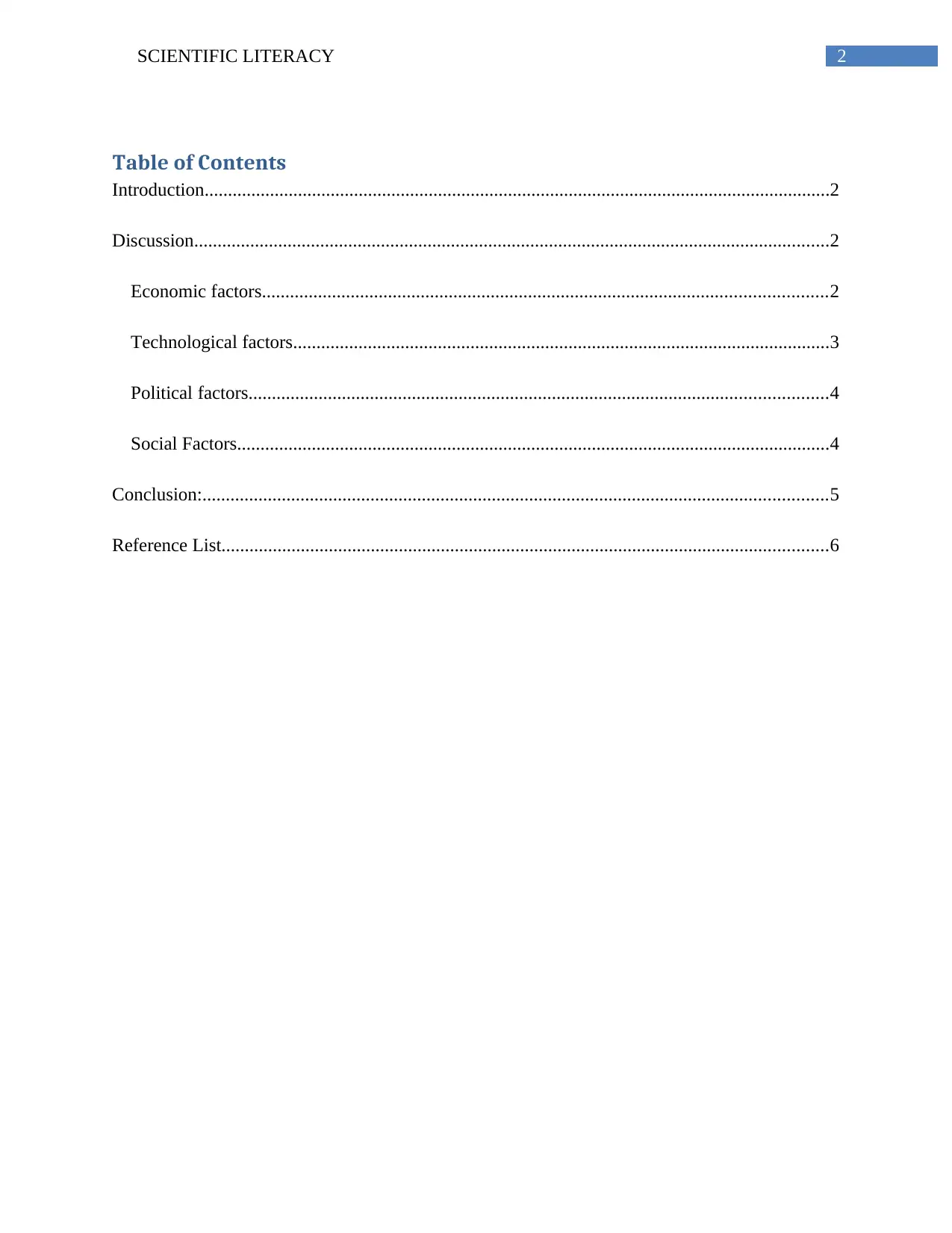
2SCIENTIFIC LITERACY
Table of Contents
Introduction......................................................................................................................................2
Discussion........................................................................................................................................2
Economic factors.........................................................................................................................2
Technological factors...................................................................................................................3
Political factors............................................................................................................................4
Social Factors...............................................................................................................................4
Conclusion:......................................................................................................................................5
Reference List..................................................................................................................................6
Table of Contents
Introduction......................................................................................................................................2
Discussion........................................................................................................................................2
Economic factors.........................................................................................................................2
Technological factors...................................................................................................................3
Political factors............................................................................................................................4
Social Factors...............................................................................................................................4
Conclusion:......................................................................................................................................5
Reference List..................................................................................................................................6
⊘ This is a preview!⊘
Do you want full access?
Subscribe today to unlock all pages.

Trusted by 1+ million students worldwide
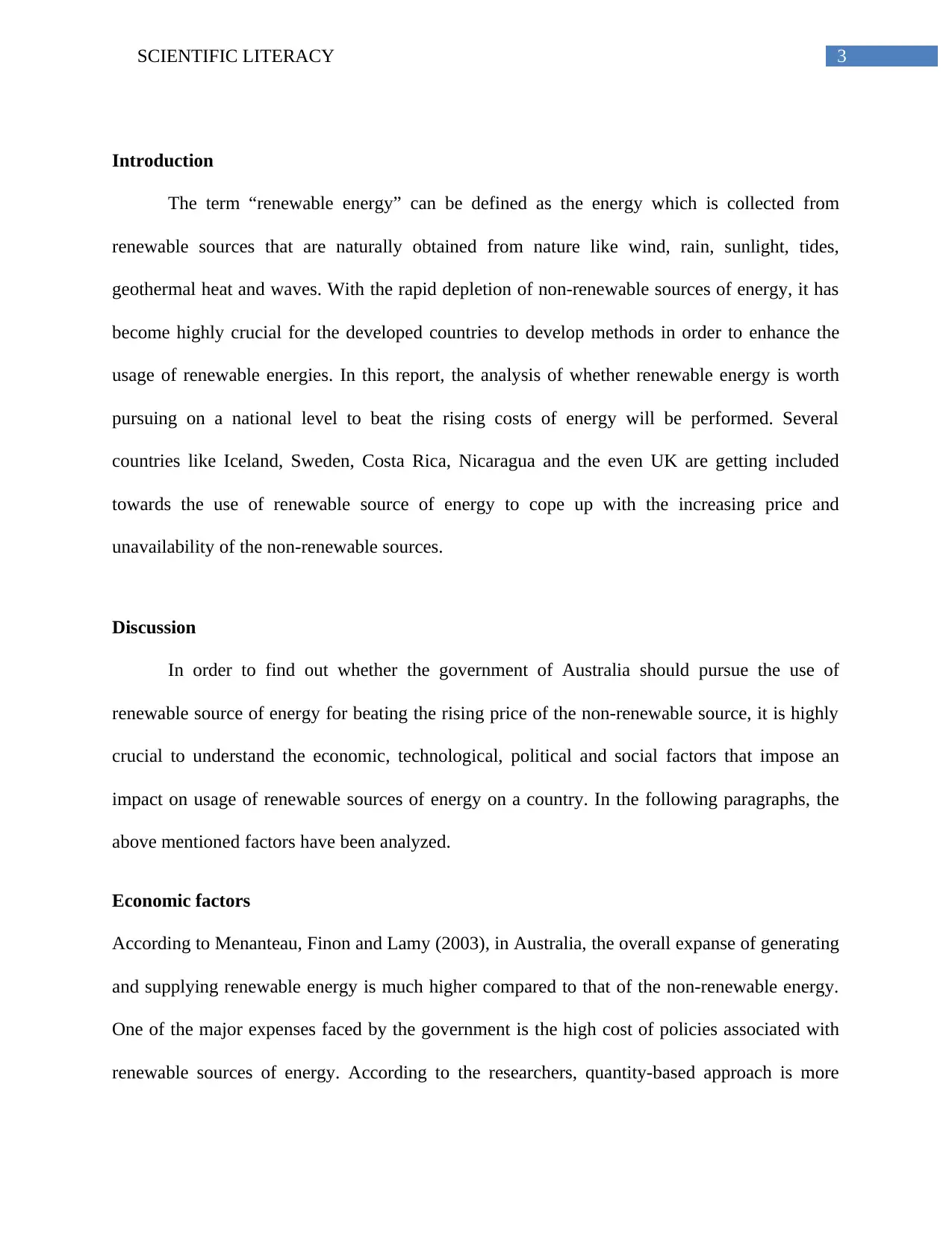
3SCIENTIFIC LITERACY
Introduction
The term “renewable energy” can be defined as the energy which is collected from
renewable sources that are naturally obtained from nature like wind, rain, sunlight, tides,
geothermal heat and waves. With the rapid depletion of non-renewable sources of energy, it has
become highly crucial for the developed countries to develop methods in order to enhance the
usage of renewable energies. In this report, the analysis of whether renewable energy is worth
pursuing on a national level to beat the rising costs of energy will be performed. Several
countries like Iceland, Sweden, Costa Rica, Nicaragua and the even UK are getting included
towards the use of renewable source of energy to cope up with the increasing price and
unavailability of the non-renewable sources.
Discussion
In order to find out whether the government of Australia should pursue the use of
renewable source of energy for beating the rising price of the non-renewable source, it is highly
crucial to understand the economic, technological, political and social factors that impose an
impact on usage of renewable sources of energy on a country. In the following paragraphs, the
above mentioned factors have been analyzed.
Economic factors
According to Menanteau, Finon and Lamy (2003), in Australia, the overall expanse of generating
and supplying renewable energy is much higher compared to that of the non-renewable energy.
One of the major expenses faced by the government is the high cost of policies associated with
renewable sources of energy. According to the researchers, quantity-based approach is more
Introduction
The term “renewable energy” can be defined as the energy which is collected from
renewable sources that are naturally obtained from nature like wind, rain, sunlight, tides,
geothermal heat and waves. With the rapid depletion of non-renewable sources of energy, it has
become highly crucial for the developed countries to develop methods in order to enhance the
usage of renewable energies. In this report, the analysis of whether renewable energy is worth
pursuing on a national level to beat the rising costs of energy will be performed. Several
countries like Iceland, Sweden, Costa Rica, Nicaragua and the even UK are getting included
towards the use of renewable source of energy to cope up with the increasing price and
unavailability of the non-renewable sources.
Discussion
In order to find out whether the government of Australia should pursue the use of
renewable source of energy for beating the rising price of the non-renewable source, it is highly
crucial to understand the economic, technological, political and social factors that impose an
impact on usage of renewable sources of energy on a country. In the following paragraphs, the
above mentioned factors have been analyzed.
Economic factors
According to Menanteau, Finon and Lamy (2003), in Australia, the overall expanse of generating
and supplying renewable energy is much higher compared to that of the non-renewable energy.
One of the major expenses faced by the government is the high cost of policies associated with
renewable sources of energy. According to the researchers, quantity-based approach is more
Paraphrase This Document
Need a fresh take? Get an instant paraphrase of this document with our AI Paraphraser
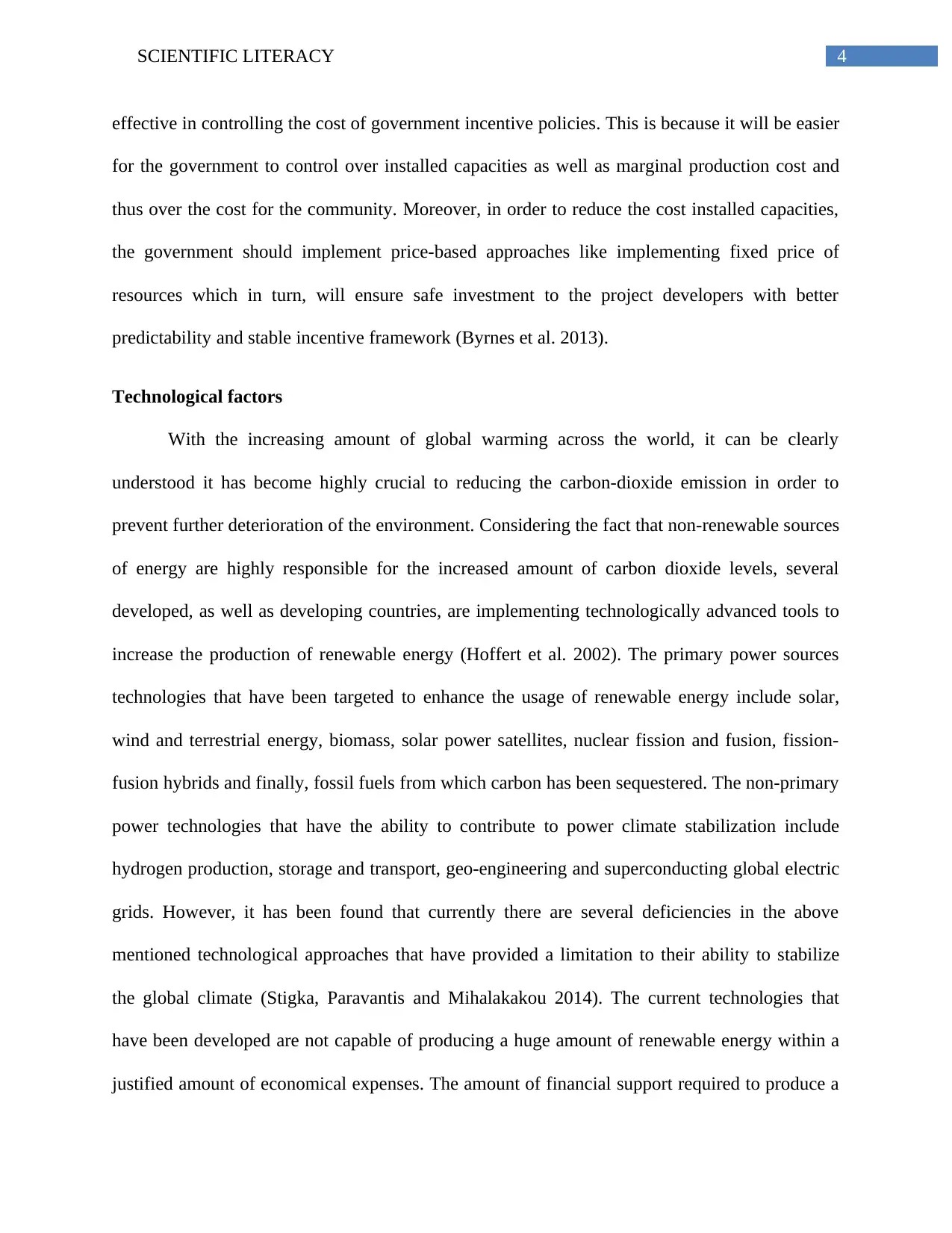
4SCIENTIFIC LITERACY
effective in controlling the cost of government incentive policies. This is because it will be easier
for the government to control over installed capacities as well as marginal production cost and
thus over the cost for the community. Moreover, in order to reduce the cost installed capacities,
the government should implement price-based approaches like implementing fixed price of
resources which in turn, will ensure safe investment to the project developers with better
predictability and stable incentive framework (Byrnes et al. 2013).
Technological factors
With the increasing amount of global warming across the world, it can be clearly
understood it has become highly crucial to reducing the carbon-dioxide emission in order to
prevent further deterioration of the environment. Considering the fact that non-renewable sources
of energy are highly responsible for the increased amount of carbon dioxide levels, several
developed, as well as developing countries, are implementing technologically advanced tools to
increase the production of renewable energy (Hoffert et al. 2002). The primary power sources
technologies that have been targeted to enhance the usage of renewable energy include solar,
wind and terrestrial energy, biomass, solar power satellites, nuclear fission and fusion, fission-
fusion hybrids and finally, fossil fuels from which carbon has been sequestered. The non-primary
power technologies that have the ability to contribute to power climate stabilization include
hydrogen production, storage and transport, geo-engineering and superconducting global electric
grids. However, it has been found that currently there are several deficiencies in the above
mentioned technological approaches that have provided a limitation to their ability to stabilize
the global climate (Stigka, Paravantis and Mihalakakou 2014). The current technologies that
have been developed are not capable of producing a huge amount of renewable energy within a
justified amount of economical expenses. The amount of financial support required to produce a
effective in controlling the cost of government incentive policies. This is because it will be easier
for the government to control over installed capacities as well as marginal production cost and
thus over the cost for the community. Moreover, in order to reduce the cost installed capacities,
the government should implement price-based approaches like implementing fixed price of
resources which in turn, will ensure safe investment to the project developers with better
predictability and stable incentive framework (Byrnes et al. 2013).
Technological factors
With the increasing amount of global warming across the world, it can be clearly
understood it has become highly crucial to reducing the carbon-dioxide emission in order to
prevent further deterioration of the environment. Considering the fact that non-renewable sources
of energy are highly responsible for the increased amount of carbon dioxide levels, several
developed, as well as developing countries, are implementing technologically advanced tools to
increase the production of renewable energy (Hoffert et al. 2002). The primary power sources
technologies that have been targeted to enhance the usage of renewable energy include solar,
wind and terrestrial energy, biomass, solar power satellites, nuclear fission and fusion, fission-
fusion hybrids and finally, fossil fuels from which carbon has been sequestered. The non-primary
power technologies that have the ability to contribute to power climate stabilization include
hydrogen production, storage and transport, geo-engineering and superconducting global electric
grids. However, it has been found that currently there are several deficiencies in the above
mentioned technological approaches that have provided a limitation to their ability to stabilize
the global climate (Stigka, Paravantis and Mihalakakou 2014). The current technologies that
have been developed are not capable of producing a huge amount of renewable energy within a
justified amount of economical expenses. The amount of financial support required to produce a
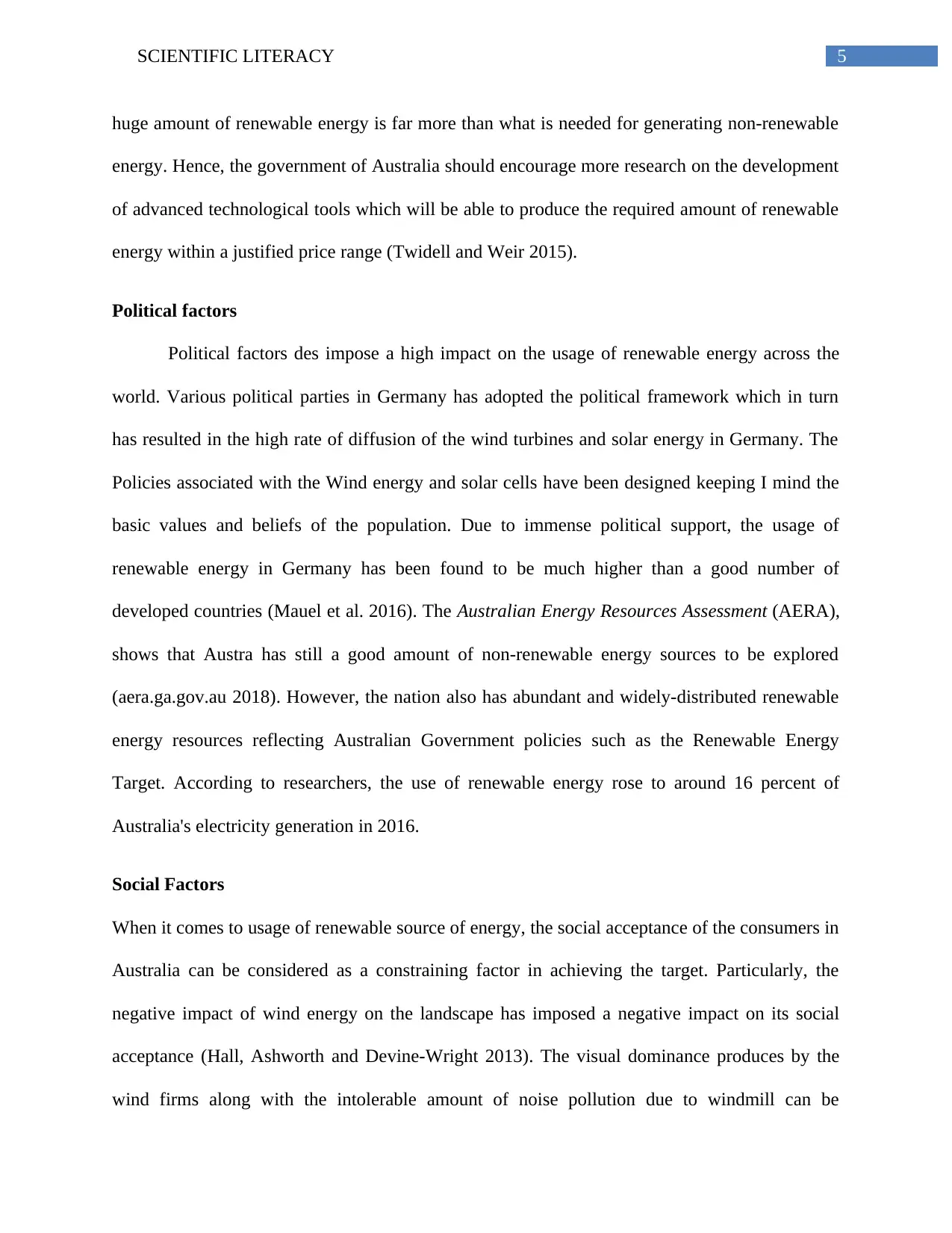
5SCIENTIFIC LITERACY
huge amount of renewable energy is far more than what is needed for generating non-renewable
energy. Hence, the government of Australia should encourage more research on the development
of advanced technological tools which will be able to produce the required amount of renewable
energy within a justified price range (Twidell and Weir 2015).
Political factors
Political factors des impose a high impact on the usage of renewable energy across the
world. Various political parties in Germany has adopted the political framework which in turn
has resulted in the high rate of diffusion of the wind turbines and solar energy in Germany. The
Policies associated with the Wind energy and solar cells have been designed keeping I mind the
basic values and beliefs of the population. Due to immense political support, the usage of
renewable energy in Germany has been found to be much higher than a good number of
developed countries (Mauel et al. 2016). The Australian Energy Resources Assessment (AERA),
shows that Austra has still a good amount of non-renewable energy sources to be explored
(aera.ga.gov.au 2018). However, the nation also has abundant and widely-distributed renewable
energy resources reflecting Australian Government policies such as the Renewable Energy
Target. According to researchers, the use of renewable energy rose to around 16 percent of
Australia's electricity generation in 2016.
Social Factors
When it comes to usage of renewable source of energy, the social acceptance of the consumers in
Australia can be considered as a constraining factor in achieving the target. Particularly, the
negative impact of wind energy on the landscape has imposed a negative impact on its social
acceptance (Hall, Ashworth and Devine-Wright 2013). The visual dominance produces by the
wind firms along with the intolerable amount of noise pollution due to windmill can be
huge amount of renewable energy is far more than what is needed for generating non-renewable
energy. Hence, the government of Australia should encourage more research on the development
of advanced technological tools which will be able to produce the required amount of renewable
energy within a justified price range (Twidell and Weir 2015).
Political factors
Political factors des impose a high impact on the usage of renewable energy across the
world. Various political parties in Germany has adopted the political framework which in turn
has resulted in the high rate of diffusion of the wind turbines and solar energy in Germany. The
Policies associated with the Wind energy and solar cells have been designed keeping I mind the
basic values and beliefs of the population. Due to immense political support, the usage of
renewable energy in Germany has been found to be much higher than a good number of
developed countries (Mauel et al. 2016). The Australian Energy Resources Assessment (AERA),
shows that Austra has still a good amount of non-renewable energy sources to be explored
(aera.ga.gov.au 2018). However, the nation also has abundant and widely-distributed renewable
energy resources reflecting Australian Government policies such as the Renewable Energy
Target. According to researchers, the use of renewable energy rose to around 16 percent of
Australia's electricity generation in 2016.
Social Factors
When it comes to usage of renewable source of energy, the social acceptance of the consumers in
Australia can be considered as a constraining factor in achieving the target. Particularly, the
negative impact of wind energy on the landscape has imposed a negative impact on its social
acceptance (Hall, Ashworth and Devine-Wright 2013). The visual dominance produces by the
wind firms along with the intolerable amount of noise pollution due to windmill can be
⊘ This is a preview!⊘
Do you want full access?
Subscribe today to unlock all pages.

Trusted by 1+ million students worldwide
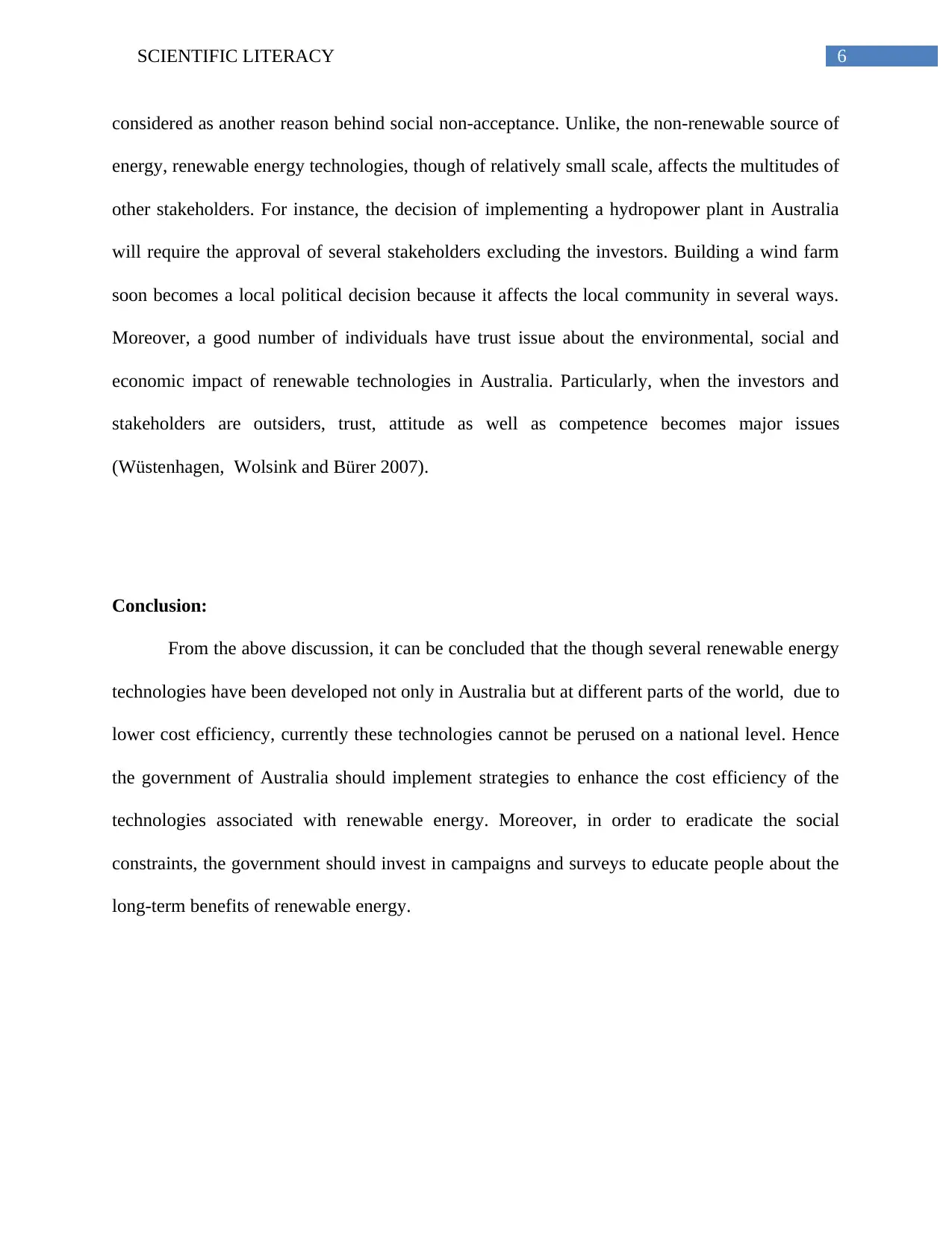
6SCIENTIFIC LITERACY
considered as another reason behind social non-acceptance. Unlike, the non-renewable source of
energy, renewable energy technologies, though of relatively small scale, affects the multitudes of
other stakeholders. For instance, the decision of implementing a hydropower plant in Australia
will require the approval of several stakeholders excluding the investors. Building a wind farm
soon becomes a local political decision because it affects the local community in several ways.
Moreover, a good number of individuals have trust issue about the environmental, social and
economic impact of renewable technologies in Australia. Particularly, when the investors and
stakeholders are outsiders, trust, attitude as well as competence becomes major issues
(Wüstenhagen, Wolsink and Bürer 2007).
Conclusion:
From the above discussion, it can be concluded that the though several renewable energy
technologies have been developed not only in Australia but at different parts of the world, due to
lower cost efficiency, currently these technologies cannot be perused on a national level. Hence
the government of Australia should implement strategies to enhance the cost efficiency of the
technologies associated with renewable energy. Moreover, in order to eradicate the social
constraints, the government should invest in campaigns and surveys to educate people about the
long-term benefits of renewable energy.
considered as another reason behind social non-acceptance. Unlike, the non-renewable source of
energy, renewable energy technologies, though of relatively small scale, affects the multitudes of
other stakeholders. For instance, the decision of implementing a hydropower plant in Australia
will require the approval of several stakeholders excluding the investors. Building a wind farm
soon becomes a local political decision because it affects the local community in several ways.
Moreover, a good number of individuals have trust issue about the environmental, social and
economic impact of renewable technologies in Australia. Particularly, when the investors and
stakeholders are outsiders, trust, attitude as well as competence becomes major issues
(Wüstenhagen, Wolsink and Bürer 2007).
Conclusion:
From the above discussion, it can be concluded that the though several renewable energy
technologies have been developed not only in Australia but at different parts of the world, due to
lower cost efficiency, currently these technologies cannot be perused on a national level. Hence
the government of Australia should implement strategies to enhance the cost efficiency of the
technologies associated with renewable energy. Moreover, in order to eradicate the social
constraints, the government should invest in campaigns and surveys to educate people about the
long-term benefits of renewable energy.
Paraphrase This Document
Need a fresh take? Get an instant paraphrase of this document with our AI Paraphraser
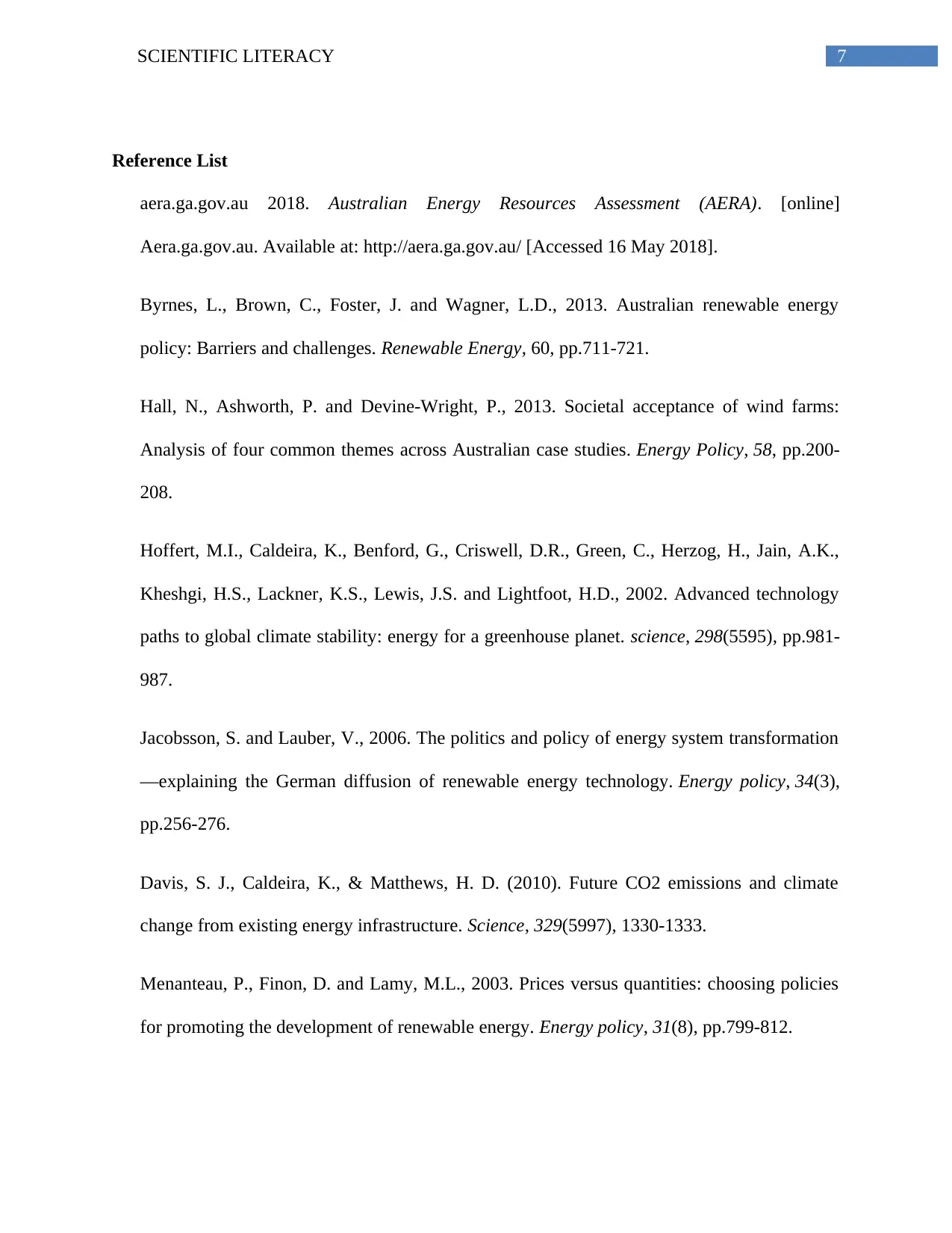
7SCIENTIFIC LITERACY
Reference List
aera.ga.gov.au 2018. Australian Energy Resources Assessment (AERA). [online]
Aera.ga.gov.au. Available at: http://aera.ga.gov.au/ [Accessed 16 May 2018].
Byrnes, L., Brown, C., Foster, J. and Wagner, L.D., 2013. Australian renewable energy
policy: Barriers and challenges. Renewable Energy, 60, pp.711-721.
Hall, N., Ashworth, P. and Devine-Wright, P., 2013. Societal acceptance of wind farms:
Analysis of four common themes across Australian case studies. Energy Policy, 58, pp.200-
208.
Hoffert, M.I., Caldeira, K., Benford, G., Criswell, D.R., Green, C., Herzog, H., Jain, A.K.,
Kheshgi, H.S., Lackner, K.S., Lewis, J.S. and Lightfoot, H.D., 2002. Advanced technology
paths to global climate stability: energy for a greenhouse planet. science, 298(5595), pp.981-
987.
Jacobsson, S. and Lauber, V., 2006. The politics and policy of energy system transformation
—explaining the German diffusion of renewable energy technology. Energy policy, 34(3),
pp.256-276.
Davis, S. J., Caldeira, K., & Matthews, H. D. (2010). Future CO2 emissions and climate
change from existing energy infrastructure. Science, 329(5997), 1330-1333.
Menanteau, P., Finon, D. and Lamy, M.L., 2003. Prices versus quantities: choosing policies
for promoting the development of renewable energy. Energy policy, 31(8), pp.799-812.
Reference List
aera.ga.gov.au 2018. Australian Energy Resources Assessment (AERA). [online]
Aera.ga.gov.au. Available at: http://aera.ga.gov.au/ [Accessed 16 May 2018].
Byrnes, L., Brown, C., Foster, J. and Wagner, L.D., 2013. Australian renewable energy
policy: Barriers and challenges. Renewable Energy, 60, pp.711-721.
Hall, N., Ashworth, P. and Devine-Wright, P., 2013. Societal acceptance of wind farms:
Analysis of four common themes across Australian case studies. Energy Policy, 58, pp.200-
208.
Hoffert, M.I., Caldeira, K., Benford, G., Criswell, D.R., Green, C., Herzog, H., Jain, A.K.,
Kheshgi, H.S., Lackner, K.S., Lewis, J.S. and Lightfoot, H.D., 2002. Advanced technology
paths to global climate stability: energy for a greenhouse planet. science, 298(5595), pp.981-
987.
Jacobsson, S. and Lauber, V., 2006. The politics and policy of energy system transformation
—explaining the German diffusion of renewable energy technology. Energy policy, 34(3),
pp.256-276.
Davis, S. J., Caldeira, K., & Matthews, H. D. (2010). Future CO2 emissions and climate
change from existing energy infrastructure. Science, 329(5997), 1330-1333.
Menanteau, P., Finon, D. and Lamy, M.L., 2003. Prices versus quantities: choosing policies
for promoting the development of renewable energy. Energy policy, 31(8), pp.799-812.
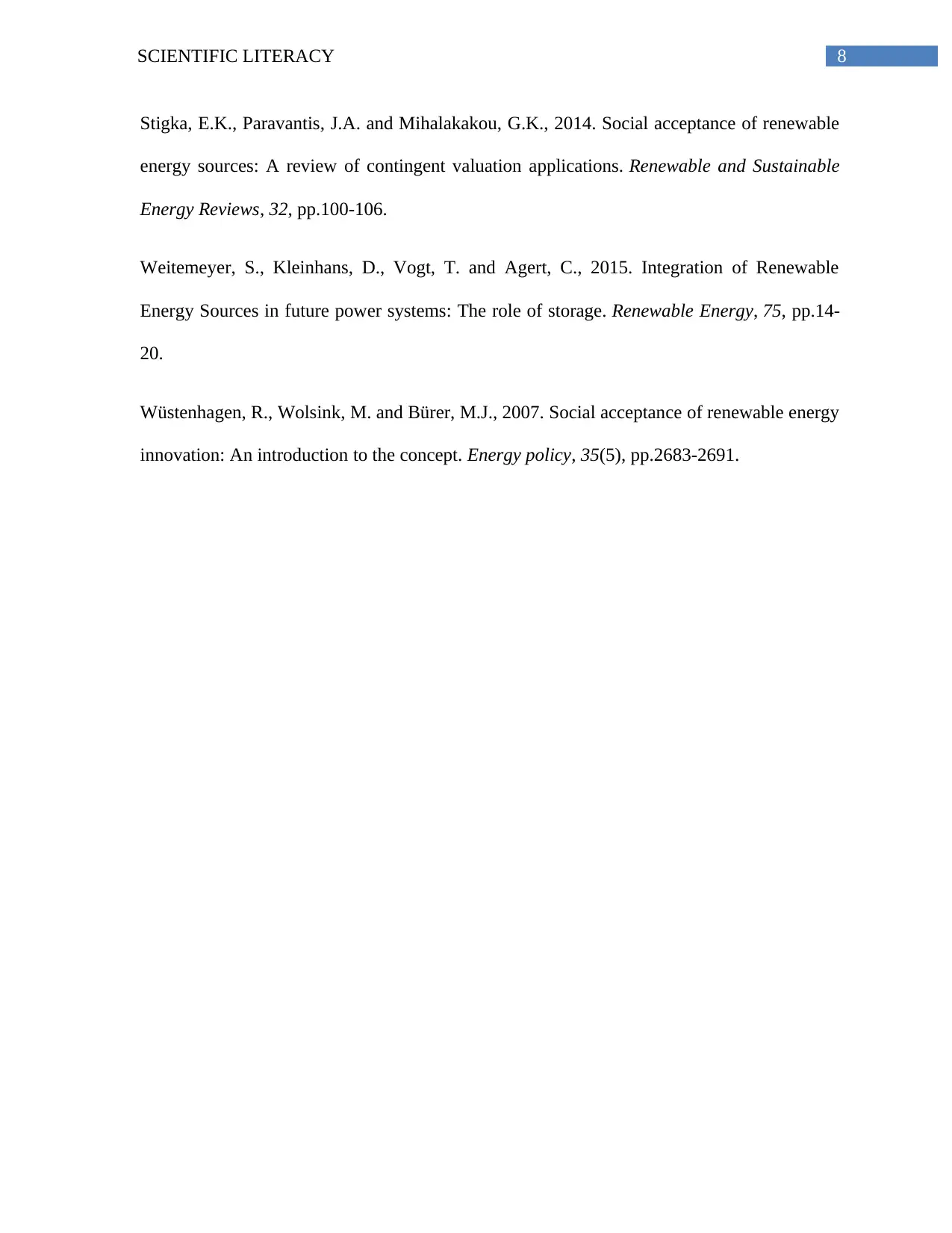
8SCIENTIFIC LITERACY
Stigka, E.K., Paravantis, J.A. and Mihalakakou, G.K., 2014. Social acceptance of renewable
energy sources: A review of contingent valuation applications. Renewable and Sustainable
Energy Reviews, 32, pp.100-106.
Weitemeyer, S., Kleinhans, D., Vogt, T. and Agert, C., 2015. Integration of Renewable
Energy Sources in future power systems: The role of storage. Renewable Energy, 75, pp.14-
20.
Wüstenhagen, R., Wolsink, M. and Bürer, M.J., 2007. Social acceptance of renewable energy
innovation: An introduction to the concept. Energy policy, 35(5), pp.2683-2691.
Stigka, E.K., Paravantis, J.A. and Mihalakakou, G.K., 2014. Social acceptance of renewable
energy sources: A review of contingent valuation applications. Renewable and Sustainable
Energy Reviews, 32, pp.100-106.
Weitemeyer, S., Kleinhans, D., Vogt, T. and Agert, C., 2015. Integration of Renewable
Energy Sources in future power systems: The role of storage. Renewable Energy, 75, pp.14-
20.
Wüstenhagen, R., Wolsink, M. and Bürer, M.J., 2007. Social acceptance of renewable energy
innovation: An introduction to the concept. Energy policy, 35(5), pp.2683-2691.
⊘ This is a preview!⊘
Do you want full access?
Subscribe today to unlock all pages.

Trusted by 1+ million students worldwide
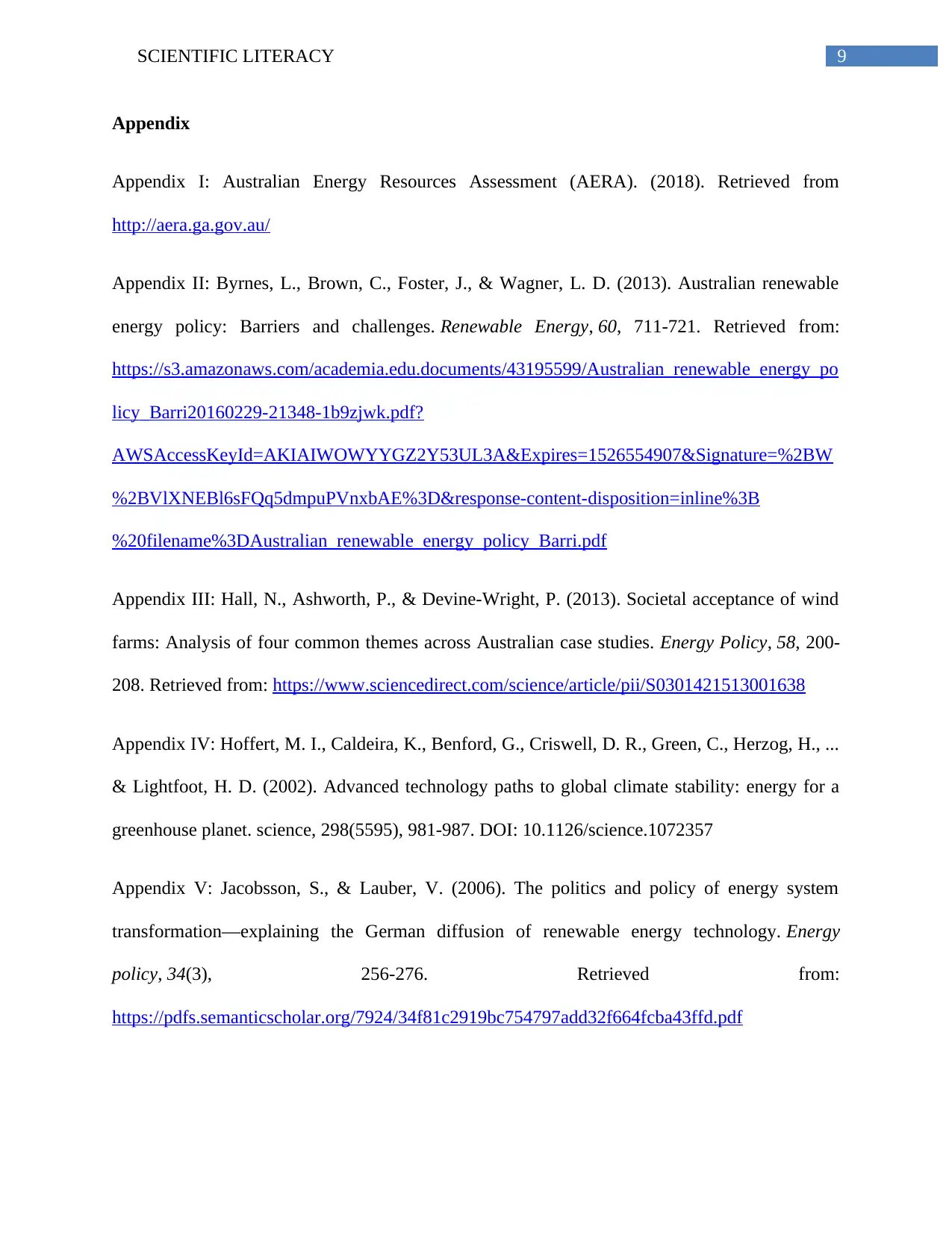
9SCIENTIFIC LITERACY
Appendix
Appendix I: Australian Energy Resources Assessment (AERA). (2018). Retrieved from
http://aera.ga.gov.au/
Appendix II: Byrnes, L., Brown, C., Foster, J., & Wagner, L. D. (2013). Australian renewable
energy policy: Barriers and challenges. Renewable Energy, 60, 711-721. Retrieved from:
https://s3.amazonaws.com/academia.edu.documents/43195599/Australian_renewable_energy_po
licy_Barri20160229-21348-1b9zjwk.pdf?
AWSAccessKeyId=AKIAIWOWYYGZ2Y53UL3A&Expires=1526554907&Signature=%2BW
%2BVlXNEBl6sFQq5dmpuPVnxbAE%3D&response-content-disposition=inline%3B
%20filename%3DAustralian_renewable_energy_policy_Barri.pdf
Appendix III: Hall, N., Ashworth, P., & Devine-Wright, P. (2013). Societal acceptance of wind
farms: Analysis of four common themes across Australian case studies. Energy Policy, 58, 200-
208. Retrieved from: https://www.sciencedirect.com/science/article/pii/S0301421513001638
Appendix IV: Hoffert, M. I., Caldeira, K., Benford, G., Criswell, D. R., Green, C., Herzog, H., ...
& Lightfoot, H. D. (2002). Advanced technology paths to global climate stability: energy for a
greenhouse planet. science, 298(5595), 981-987. DOI: 10.1126/science.1072357
Appendix V: Jacobsson, S., & Lauber, V. (2006). The politics and policy of energy system
transformation—explaining the German diffusion of renewable energy technology. Energy
policy, 34(3), 256-276. Retrieved from:
https://pdfs.semanticscholar.org/7924/34f81c2919bc754797add32f664fcba43ffd.pdf
Appendix
Appendix I: Australian Energy Resources Assessment (AERA). (2018). Retrieved from
http://aera.ga.gov.au/
Appendix II: Byrnes, L., Brown, C., Foster, J., & Wagner, L. D. (2013). Australian renewable
energy policy: Barriers and challenges. Renewable Energy, 60, 711-721. Retrieved from:
https://s3.amazonaws.com/academia.edu.documents/43195599/Australian_renewable_energy_po
licy_Barri20160229-21348-1b9zjwk.pdf?
AWSAccessKeyId=AKIAIWOWYYGZ2Y53UL3A&Expires=1526554907&Signature=%2BW
%2BVlXNEBl6sFQq5dmpuPVnxbAE%3D&response-content-disposition=inline%3B
%20filename%3DAustralian_renewable_energy_policy_Barri.pdf
Appendix III: Hall, N., Ashworth, P., & Devine-Wright, P. (2013). Societal acceptance of wind
farms: Analysis of four common themes across Australian case studies. Energy Policy, 58, 200-
208. Retrieved from: https://www.sciencedirect.com/science/article/pii/S0301421513001638
Appendix IV: Hoffert, M. I., Caldeira, K., Benford, G., Criswell, D. R., Green, C., Herzog, H., ...
& Lightfoot, H. D. (2002). Advanced technology paths to global climate stability: energy for a
greenhouse planet. science, 298(5595), 981-987. DOI: 10.1126/science.1072357
Appendix V: Jacobsson, S., & Lauber, V. (2006). The politics and policy of energy system
transformation—explaining the German diffusion of renewable energy technology. Energy
policy, 34(3), 256-276. Retrieved from:
https://pdfs.semanticscholar.org/7924/34f81c2919bc754797add32f664fcba43ffd.pdf
Paraphrase This Document
Need a fresh take? Get an instant paraphrase of this document with our AI Paraphraser
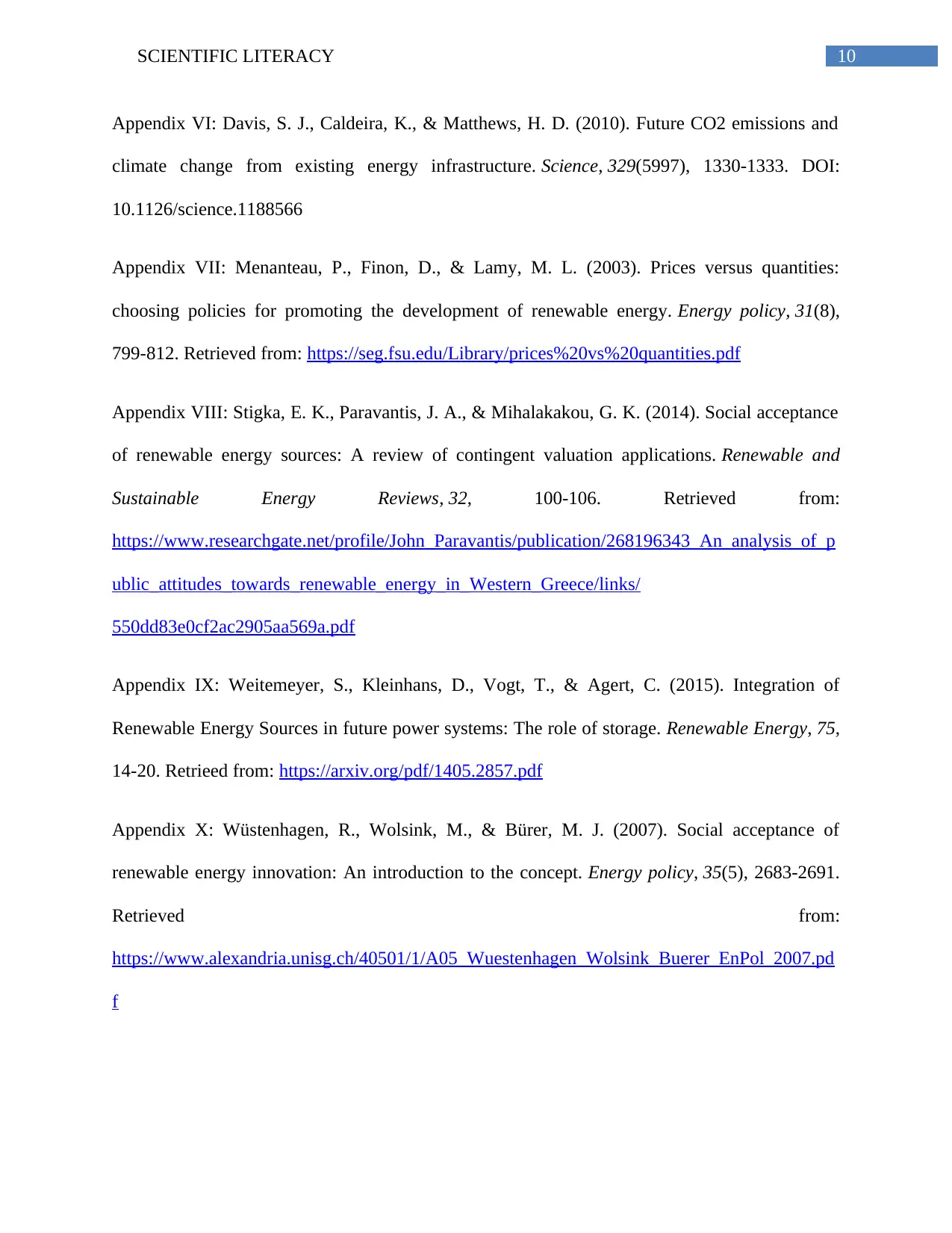
10SCIENTIFIC LITERACY
Appendix VI: Davis, S. J., Caldeira, K., & Matthews, H. D. (2010). Future CO2 emissions and
climate change from existing energy infrastructure. Science, 329(5997), 1330-1333. DOI:
10.1126/science.1188566
Appendix VII: Menanteau, P., Finon, D., & Lamy, M. L. (2003). Prices versus quantities:
choosing policies for promoting the development of renewable energy. Energy policy, 31(8),
799-812. Retrieved from: https://seg.fsu.edu/Library/prices%20vs%20quantities.pdf
Appendix VIII: Stigka, E. K., Paravantis, J. A., & Mihalakakou, G. K. (2014). Social acceptance
of renewable energy sources: A review of contingent valuation applications. Renewable and
Sustainable Energy Reviews, 32, 100-106. Retrieved from:
https://www.researchgate.net/profile/John_Paravantis/publication/268196343_An_analysis_of_p
ublic_attitudes_towards_renewable_energy_in_Western_Greece/links/
550dd83e0cf2ac2905aa569a.pdf
Appendix IX: Weitemeyer, S., Kleinhans, D., Vogt, T., & Agert, C. (2015). Integration of
Renewable Energy Sources in future power systems: The role of storage. Renewable Energy, 75,
14-20. Retrieed from: https://arxiv.org/pdf/1405.2857.pdf
Appendix X: Wüstenhagen, R., Wolsink, M., & Bürer, M. J. (2007). Social acceptance of
renewable energy innovation: An introduction to the concept. Energy policy, 35(5), 2683-2691.
Retrieved from:
https://www.alexandria.unisg.ch/40501/1/A05_Wuestenhagen_Wolsink_Buerer_EnPol_2007.pd
f
Appendix VI: Davis, S. J., Caldeira, K., & Matthews, H. D. (2010). Future CO2 emissions and
climate change from existing energy infrastructure. Science, 329(5997), 1330-1333. DOI:
10.1126/science.1188566
Appendix VII: Menanteau, P., Finon, D., & Lamy, M. L. (2003). Prices versus quantities:
choosing policies for promoting the development of renewable energy. Energy policy, 31(8),
799-812. Retrieved from: https://seg.fsu.edu/Library/prices%20vs%20quantities.pdf
Appendix VIII: Stigka, E. K., Paravantis, J. A., & Mihalakakou, G. K. (2014). Social acceptance
of renewable energy sources: A review of contingent valuation applications. Renewable and
Sustainable Energy Reviews, 32, 100-106. Retrieved from:
https://www.researchgate.net/profile/John_Paravantis/publication/268196343_An_analysis_of_p
ublic_attitudes_towards_renewable_energy_in_Western_Greece/links/
550dd83e0cf2ac2905aa569a.pdf
Appendix IX: Weitemeyer, S., Kleinhans, D., Vogt, T., & Agert, C. (2015). Integration of
Renewable Energy Sources in future power systems: The role of storage. Renewable Energy, 75,
14-20. Retrieed from: https://arxiv.org/pdf/1405.2857.pdf
Appendix X: Wüstenhagen, R., Wolsink, M., & Bürer, M. J. (2007). Social acceptance of
renewable energy innovation: An introduction to the concept. Energy policy, 35(5), 2683-2691.
Retrieved from:
https://www.alexandria.unisg.ch/40501/1/A05_Wuestenhagen_Wolsink_Buerer_EnPol_2007.pd
f
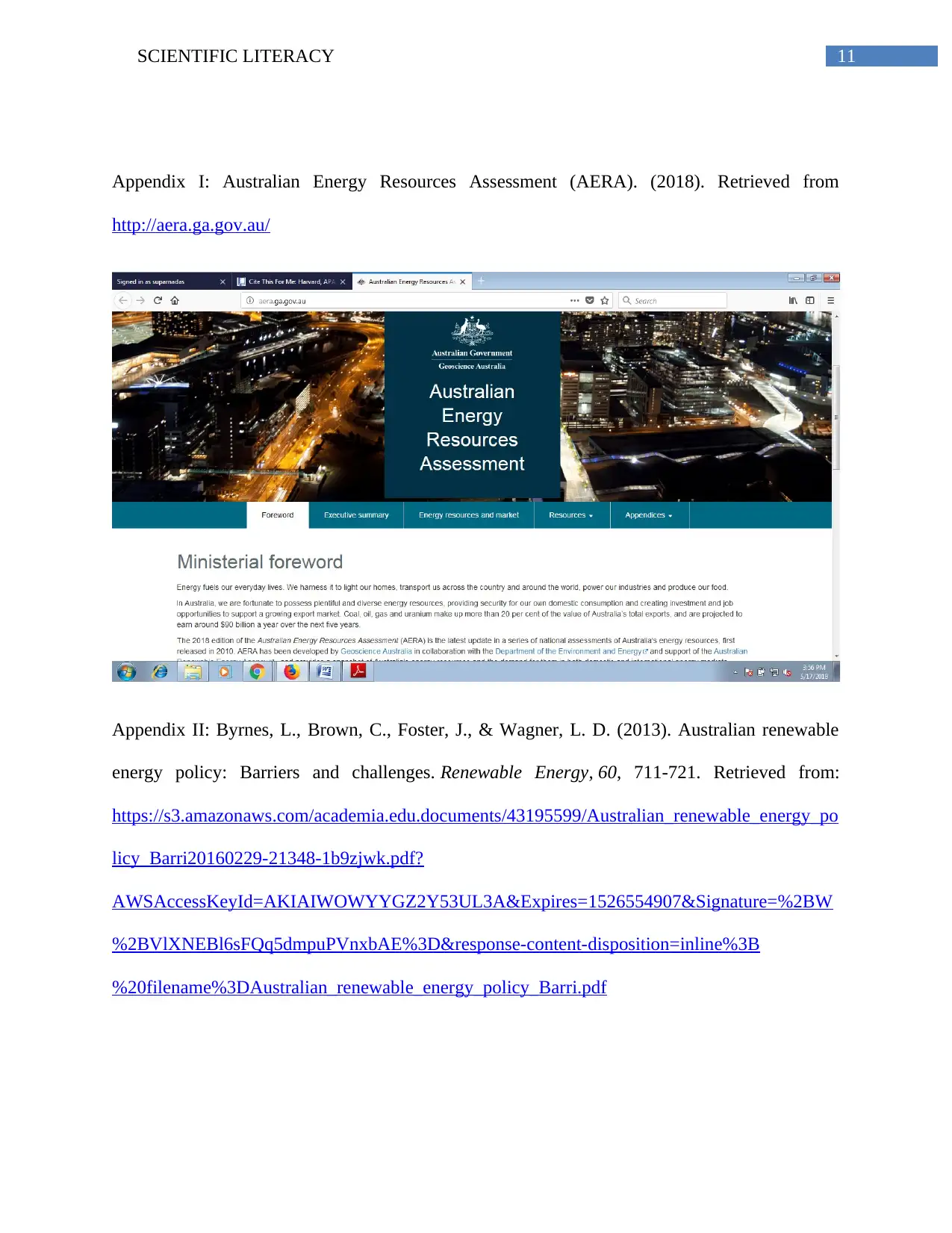
11SCIENTIFIC LITERACY
Appendix I: Australian Energy Resources Assessment (AERA). (2018). Retrieved from
http://aera.ga.gov.au/
Appendix II: Byrnes, L., Brown, C., Foster, J., & Wagner, L. D. (2013). Australian renewable
energy policy: Barriers and challenges. Renewable Energy, 60, 711-721. Retrieved from:
https://s3.amazonaws.com/academia.edu.documents/43195599/Australian_renewable_energy_po
licy_Barri20160229-21348-1b9zjwk.pdf?
AWSAccessKeyId=AKIAIWOWYYGZ2Y53UL3A&Expires=1526554907&Signature=%2BW
%2BVlXNEBl6sFQq5dmpuPVnxbAE%3D&response-content-disposition=inline%3B
%20filename%3DAustralian_renewable_energy_policy_Barri.pdf
Appendix I: Australian Energy Resources Assessment (AERA). (2018). Retrieved from
http://aera.ga.gov.au/
Appendix II: Byrnes, L., Brown, C., Foster, J., & Wagner, L. D. (2013). Australian renewable
energy policy: Barriers and challenges. Renewable Energy, 60, 711-721. Retrieved from:
https://s3.amazonaws.com/academia.edu.documents/43195599/Australian_renewable_energy_po
licy_Barri20160229-21348-1b9zjwk.pdf?
AWSAccessKeyId=AKIAIWOWYYGZ2Y53UL3A&Expires=1526554907&Signature=%2BW
%2BVlXNEBl6sFQq5dmpuPVnxbAE%3D&response-content-disposition=inline%3B
%20filename%3DAustralian_renewable_energy_policy_Barri.pdf
⊘ This is a preview!⊘
Do you want full access?
Subscribe today to unlock all pages.

Trusted by 1+ million students worldwide
1 out of 18
Related Documents
Your All-in-One AI-Powered Toolkit for Academic Success.
+13062052269
info@desklib.com
Available 24*7 on WhatsApp / Email
![[object Object]](/_next/static/media/star-bottom.7253800d.svg)
Unlock your academic potential
Copyright © 2020–2025 A2Z Services. All Rights Reserved. Developed and managed by ZUCOL.





